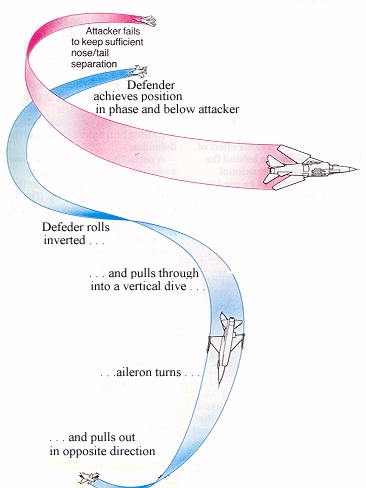

In this the defender rolls inverted and dives away vertically, pulling out in a direction opposite to that of his opponent.
Most defensive maneuvres are designed to counter an attack coming from astern, mainly by forcing an attacker to overshoot. What are the attacker's needs? Much depends on weather he is planning a missile or gun attack. A missile attack shouls be fast, deadly, and conclusive. But, as WW I German Cheif of Staff von Moltke observed many years ago: plans rarly surive contact with the enemy. The fighter pilot should be prepared for his attack to fail and know percisely what he will do next, either enter into a maneuvring combat.
If his attack is form head-on, much will depend on the maneuvre potential of the two opponents. The more maneuvrrable fighter will have the edge in a turning fight. (The more maneuvrable fighter at this stage is frequently the one travelling slowest rather than the one most aerodynamically capable.) If this is the attacker he should endeavor to pass wide of his opponent to give himself turning room. If there is any doubt about relative maneuvre potential he should pass close to deny his adversary turning room, then pullhigh in the turn. In either case he should pass down-Sun so that his next change od direction forces his opponent to look into the dazzle. If after a head-on pass both aircraft pull high a vertical ascending scissors may result.
A missile attack from astern is normaly made at high closing speed. If the attacker must zoom climb to dissipate his excess speed if he wishes to continue the fight, although it is easier and probally safer to disengage at this point. A gun attack should be made with am overtake speed of about 50 konts (just under 90 feet, 27m per secound). This gives time to track the target in the sight, minimises the risk of overshooting and retains an energy advantage for maneuvring combat.
The defensive maneuvres described earlier place much stress on forcing an attacker to overshoot. It is obviously important to avoid overshooting, so how is it done?
An overshoot is caused by one of two factors. The first is an excessively large angle substended between the fuselages of the respective aircraft. The secound is excessive closing speed. This is difficult for the attacker to spot until he is fairly close in. Either way the attacker is faced overshooting. His first remedy is the High-speed Yoyo